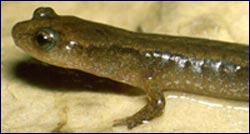Habitat microstructure drives salamander metamorphosis

Oklahoman salamander
Whether salamanders transform into their terrestrial, adult form or retain their aquatic, juvenile form depends on the nature of the streambed where they develop. A study published today in the open access journal BMC Biology reveals that the Oklahoma salamander Eurycea tynerensis metamorphoses into a more terrestrial adult form in streambeds composed of fine, tightly packed gravel but retains its juvenile, or paedomorphic, form in streambeds made of large, loosely packed particles. This study highlights how a simple difference in habitat microstructure can have a major influence on patterns of development, morphology and evolution.
Ronald Bonett and Paul Chippindale from the University of Texas at Arlington, Texas, USA, analysed the type, size and degree of sorting of streambed sediments for 22 populations, 11 paedomorphic and 11 metamorphic, of the plethodontid salamander E. tynerensis living on the Ozark Plateau in south-central North America.
Bonett and Chippindale’s results show that paedomorphic salamanders prevailed in streambeds made of large well-sorted gravel, whereas metamorphic salamanders were found where streambeds consisted of small, unsorted sediments. The authors found a strong negative correlation between small streambed sediments and paedomorphosis.
Bonett and Chippindale explain that large gravel creates porous streambeds with large spaces between particles, where aquatic paedomorphic salamanders can access sub-surface water during dry months. However, if these spaces are filled in by small particles, metamorphosis is the only way they can survive when surface streams dry-up.
Media Contact
More Information:
http://www.biomedcentral.comAll latest news from the category: Life Sciences and Chemistry
Articles and reports from the Life Sciences and chemistry area deal with applied and basic research into modern biology, chemistry and human medicine.
Valuable information can be found on a range of life sciences fields including bacteriology, biochemistry, bionics, bioinformatics, biophysics, biotechnology, genetics, geobotany, human biology, marine biology, microbiology, molecular biology, cellular biology, zoology, bioinorganic chemistry, microchemistry and environmental chemistry.
Newest articles

A universal framework for spatial biology
SpatialData is a freely accessible tool to unify and integrate data from different omics technologies accounting for spatial information, which can provide holistic insights into health and disease. Biological processes…

How complex biological processes arise
A $20 million grant from the U.S. National Science Foundation (NSF) will support the establishment and operation of the National Synthesis Center for Emergence in the Molecular and Cellular Sciences (NCEMS) at…

Airborne single-photon lidar system achieves high-resolution 3D imaging
Compact, low-power system opens doors for photon-efficient drone and satellite-based environmental monitoring and mapping. Researchers have developed a compact and lightweight single-photon airborne lidar system that can acquire high-resolution 3D…





















